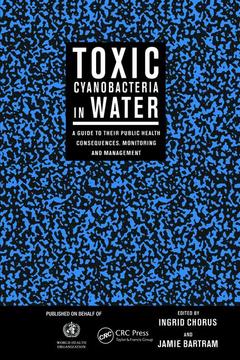Description
Toxic Cyanobacteria in Water: A Guide to Their Public Health Consequences, Monitoring & Management
A Guide to their Public Health Consequences, Monitoring and Management
Coordinators: Chorus Ingrid, Bartram Jamie
Language: English
Subject for Toxic Cyanobacteria in Water: A Guide to Their Public...:
Publication date: 08-2017
· Hardback
· Hardback
Description
/li>Contents
/li>Biography
/li>Comment
/li>
Cyanobacteria and their toxins are an increasingly global health menace. Here, leading experts examine the increasing need to protect drinking water and water resources from the hazards of Cyanobacteria and their impact on health.
Foreword. Acknowledgements. Introduction. Water resources. Eutrophication., cynobacterial blooms and surface scums. Toxic cyanobacteria and other water-related health problems. Present state of knowledge. Structure and purpose of this book. References. Cyanobacteria in the environment. Nature and diversity. Factors affecting bloom formation. Cyanobacterial ecostrategists. Additional information. References. Cyanobacterial Toxins. Classification. Occurrence of cyanotoxins. Production and regulation. Fate in the environment. Impact on aquatic biota. References. Human Health Aspects. Human and animal poisonings. Toxicological studies. References. Safe Levels and Safe Practices. Tolerable exposures. Safe Practices. Other exposure routes. Tastes and odours. References. Situation Assessment, Planning and Management. The risk-management framework. Situation assessment. Management actions, the Alert Levels Framework. Planning and response. References. Implementation of Management Plans. Organisations, agencies and groups. Policy tools. Legislation, regulations and standards. Awareness raising, communication and public participation. References. Preventative Measures. Carrying capacity. Target values for total phosphorous within water bodies. Target values for total phosphorous inputs to water bodies. Sources and reduction of external nutrient and cyanobacterial control. References. Remedial Measures. Management of abstraction. Use of algicides. Efficiency of drinking water treatment in cyanotoxin removal. Chemical oxidation and disinfection. Membrane processess and reverse osmosis. Microcystins other than microcystin-LR. Effective drinking water treatment at treatment works. Drinking water treatment for households and small community supplies. References. Design of Monitoring Programmes. Approaches to monitoring programme development. Laboratory capacities and staff training. Reactive versus programmed monitoring strategies. Sample site selection. Monitoring frequency. References. Fieldwork: Site Inspection and Sampling. Planning for fieldwork. Site inspection. Sampling. Nutrients, cyanobacteria and toxins. On-site analysis. Field records. Sample preservation and transport. References. Determination of Cyanobacteria in the Laboratory. Sample handling and storage. Cyanobacterial identification. Quantification. Determination of biomass using chlorophyll a analysis. Determination of nutrient concentrations. References. Laboratory Analysis of Cyanotoxins. Sample handling and storage. Sample preperation for cyanotoxin determination and bioassays. Toxicity tests and bioassays. Analytical methods for cyanotoxins. References. Index.
Ingrid Chorus is Head of Department of Drinking-Water and Swimming-Pool Hygiene at Umweltbundesamt, Berlin.
Jamie Bartram is a Distinguished Professor in the Department of Environmental Sciences and Engineering at the University of North Carolina at Chapel Hill.
Cyanobacteria and their toxins are an increasingly global health menace. Here, leading experts examine the increasing need to protect drinking water and water resources from the hazards of Cyanobacteria and their impact on health.
© 2024 LAVOISIER S.A.S.




